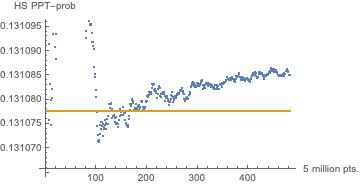Let us consider approaching the problem from a numerical (random-matrix) viewpoint, denoting the matrices in question by $\rho_{nm}$ and, first, considering the use of the measure generated by the Hilbert-Schmidt metric \begin{equation} \mbox{d} s^2_{HS}=\frac{1}{2} \mbox{Tr}[(\mbox{d} \rho_{nm})^2]. \end{equation}
Say we are interested in the proportion of $n m \times n m$ matrices of rank $k$ that remain positive-definite under the indicated operation of partial transposition, and desire to generate a matrix in that class random with respect to the Hilbert-Schmidt measure.
A procedure to do so—based on the Wishart-Laguerre distribution—has been outlined (not yet published) by K. Zyczkowski and the group of A. Khevelidze, I. Rogojin and V. Abgaryan.
In the case of Hermitian matrices, one generates a $k \times k+ 2 (nm -k)$ matrix $G$, the entries of which are complex numbers, the real and imaginary parts being normal random variates. Then, $G G^\dagger$ is normalized to have trace 1. (If $k=n m$, this is the desired density matrix. RandomMatrix) If $k<nm$, the normalized matrix is diagonalized fo obtain an $k \times k$ matrix which is extended to an $nm \times nm$ matrix, the additional entries being zeros. Rotating this expanded matrix by a random unitary, the desired $nm \times nm$ matrix $\rho_{nm}$, random with respect to the Hilbert-Schmidt measure on the $nm \times nm$ Hermitian, positive-definite, trace 1 matrices of rank $k$ is obtained.
In the case of symmetric matrices, one generates a $k \times k+ 2 (nm -k)+1$ matrix $G$, the entries of which are normal random variates. Then, $G G^T$ is normalized to have trace 1. (If $k=n m$, this is the desired density matrix.) If $k<nm$, it is diagonalized fo obtain an $k \times k$ matrix which is extended to an $nm \times nm$ matrix, the additional entries being zeros. Rotating this expanded matrix by a random orthogonal one, the desired $nm \times nm$ matrix $\rho_{nm}$, random with respect to the Hilbert-Schmidt measure on the $nm \times nm$ symmetric, positive-definite, trace 1 matrices of rank $k$ is obtained.
We currently are implementing this procedure in two cases.
In one, we are analyzing $6 \times 6$ (rebit-retrit) density matrices of rank 4. Based on 385 million randomly generated (in the indicated manner) such matrices, we obtain an estimate of a probability of 0.00773766 of having a positive partial-transpose (equivalent to separability in this case).
Relatedly, in a previous study,
we had advanced a conjecture of $\frac{860}{6561} =\frac{2 \cdot 5 \cdot 43}{3^8} \approx 0.131078$ for the $6 \times 6$ symmetric density matrices of full rank (6).
(It has been formally proven that in the $4 \times 4$ counterpart, the Hilbert-Schmidt probability is $\frac{29}{64}=\frac{29}{2^6}$ LovasAndai MasterLovasAndai .) Now, we find it intriguing to propose a rank-4 conjecture of $\frac{387}{50000} =\frac{3^2 \cdot 43}{2^4 \cdot 5^5} = 0.00774$. Subject to these two conjectures, the ratio of the rank-4 to rank-6 probabilities would be $\frac{59049}{1000000}=\frac{3^{10}}{2^5 \cdot 5^5} \approx 0.059049$, with the common factor 43 cancelling.
Our second ongoing study is concerned with the rank-6 $(4 \times 2) \times (4 \times 2) $ Hermitian density matrices, so far--based on 149 million random matrices--obtaining estimates of 0.00129085 and 0.000054624 for the full-rank and rank-6 Hilbert-Schmidt probabilities, respectively.


